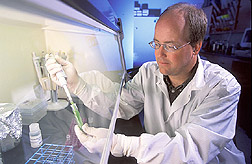This page has been archived and is being provided for reference purposes only. The page is no longer being updated, and therefore, links on the page may be invalid.
|
Pathogen Monitoring Made Easier With Paint Can Shakers
By Jan SuszkiwJune 27, 2005
George Vandemark likes his DNA (deoxyribonucleic acid) "shaken, not stirred"--recalling the fictional British secret agent James Bond. Stirring, or centrifugation, is a key step by which diagnostic labs genetically identify crop pathogens inhabiting farmers' soils.
But shaking, not stirring, the DNA may give farmers more bang for their diagnostic buck, reports Vandemark, an Agricultural Research Service geneticist in Prosser, Wash.
Normally, diagnosticians use centrifugation to separate pathogen DNA from other soil sample debris. Polymerase chain reaction and other so-called fingerprinting steps then determine whether the DNA's genetic patterns match those of a particular crop pathogen. The problem is, today's DNA extraction kits only work with 10-gram soil samples. And at around $15 per test, such extraction can become prohibitive for field-wide surveys--for example, to choose appropriate fungicides or resistant crop varieties, according to Vandemark, in ARS' Vegetable and Forage Crop Research Unit in Prosser.
His solution was to use paint can shakers, like those used in hardware stores. Instead of paint, though, he modified the shakers to hold test tubes capable of storing 70 grams of soil. To the tubes, he adds small glass beads and a buffer. The beads smash the cells of pathogens in the sample while the buffer protects their escaping DNA from damage by enzymes. After extraction, Vandemark uses PCR-based fingerprinting to determine the pathogen's genetic identity.
He began experimenting with the paint can shaker idea in 2004, and has used it to extract miscellaneous DNA from three different soil types in the Columbia Basin. His chief targets are Verticillium, Phytophthora and Fusarium fungi that plague Pacific Northwest potatoes, which comprise over half the nation's $3 billion tuber crop. Detecting DNA of soil-borne roundworms that cause disease of potatoes is another goal.
Vandemark plans more tests using different soil types and welcomes commercial interest in refining the modification, which he estimates could save farmers hundreds of dollars per field in disease-diagnostic costs.
ARS is the U.S. Department of Agriculture's chief scientific research agency.

